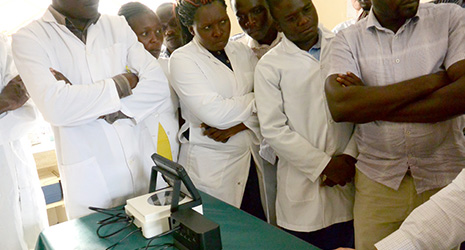Home > Highlighting JAPAN > Highlighting Japan January 2018 > Sustainable Technologies from Japan
Highlighting JAPAN


A New Diagnostic Technology for Malaria
A Japanese researcher is tackling the elimination of malaria, one of the world’s most deadly infectious diseases.
The National Institute of Advanced Industrial Science and Technology (AIST) is one of the largest public research organizations in Japan. AIST aims to create technology that contributes to industry and society and put it into practical use. Masatoshi Kataoka, who belongs to one of its divisions, the Health Research Institute, is working on the practical application and commercialization of an early diagnosis device for malaria.
Malaria is a parasitic infection of erythrocytes (red blood cells) that is typically transmitted through the bites of infected Anopheles mosquitoes, and it remains one of the world’s most deadly infectious diseases. There were an estimated 216 million cases of malaria in 2016, in which year malaria deaths reached around 445,000 (data from World Health Organization [WHO]).
The diagnostic method for malaria that the WHO currently recommends is an accurate one in which a microscope is used to detect the malaria parasite in the erythrocytes, but it takes time and moreover, its accuracy depends on the skills of the operator. An easy-to-use diagnostic method is not accurate enough, partly because a false-positive reaction is shown in individuals with a history of having had malaria in the past. On the other hand, a more reliable diagnostic method, though not recommended by WHO because the number of cases is limited, requires expensive special equipment and reagent, and complex operations. There are no methods without drawbacks. Accordingly, in countries in Africa, where malaria occurs frequently, malaria drugs are likely to be prescribed to patients who develop a fever during the second half of the rainy season, the epidemic season, without screening.
Kataoka warns about this situation, saying, “It is hazardous to prescribe drugs without careful consideration, because the malaria parasite is acquiring drug resistance. In fact, an effective drug that was used around 1940 has already become ineffective against malaria.”
Kataoka specializes in research on a biomarker for detecting substances in the blood to diagnose the presence or absence of and staging of diseases. As a diagnostic method for malaria, he focused on the fact that erythrocytes have no nucleus, while the malaria parasite does. He thought that by utilizing this fact, if a fluorescent nucleus stain solution were used for erythrocytes, stained erythrocytes that are infected with malaria could be detected. The team led by Kataoka developed a cell microarray chip system in which a polystyrene chip with microchambers is used for placing erythrocytes to detect infection with the malaria parasite. The team has developed a more accurate, highly sensitive diagnostic method than any other method ever developed.
In the laboratory, a centrifuge machine for removing only erythrocytes from the blood and a high-performance scanner for reading the image of the stained nucleus were used in an experiment, but it is not easy to disseminate similar equipment in Africa. The team then began the co-development of a portable, battery-powered diagnostic device that can be operated easily and used anywhere jointly with a Japanese electrical manufacturer, which has technology for reading images from DVD players, etc. “No matter how excellent our technology is, it is meaningless if it cannot be disseminated. In that regard, the company has a great deal of knowledge for the development of a product from the standpoint of users,” says Kataoka. A verification test of the diagnostic device was performed in a town to the north of Kampala, the capital of the Republic of Uganda, in cooperation with Gulu University. The team responded to issues that could be found only on site, such as erroneous data caused by a large amount of sand dust, one by one to improve the device, spending five years on its development and reaching the final phase of commercialization now.
After the collection of a small amount of blood, the device can diagnose nine individuals at once in about 15 minutes. Moreover, it can find one parasite in two million erythrocytes accurately, and can also analyze the infection rate for all the erythrocytes. If mass screening is performed by using this diagnostic device, it is possible to detect infected patients who have not developed malaria and to prevent the dispersal of the malaria parasite by these infected patients within the area.
Furthermore, Kataoka commenced joint research on the prevention of malaria infection with Nagasaki University in 2015. Nagasaki University has a site in Kenya, with a track record of long-term research on climate change and insect vectors related to the occurrence of tropical diseases.
“We oppose the idea of eradicating mosquitoes to eliminate malaria. Eradicating an insect could lead to alterations to and the destruction of the environment. Instead, we think that with accurate early diagnosis and appropriate treatment, we can also control malaria as we do with other diseases,” says Kataoka.
Currently, Kataoka is seeking feedback from WHO on what type of data is required so that the device developed by his team can be recommended as a diagnostic device for malaria by WHO. To eliminate malaria, which WHO aims to achieve, a significant contribution to the solution of a global issue is expected of the combination of the early diagnosis system that Kataoka and his team have developed and Nagasaki University’s research achievements.
© 2009 Cabinet Office, Government of Japan







